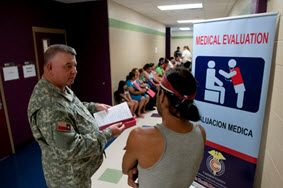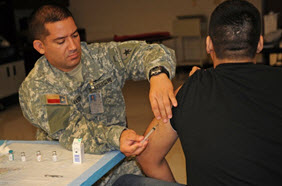By: Brig. Gen. David Cohen
 Sgt. William Alford, Tyler Medical Response Group, Texas State Guard assists with the flow of patients during Operation Lone Star 2013 in Brownsville, TX. Operation Lone Star serves as the only access to medical care that residents of the South Texas Border Region have to medical care or doctors. (U.S. Army National Guard photo by Spec. Aaron Moreno.)
Sgt. William Alford, Tyler Medical Response Group, Texas State Guard assists with the flow of patients during Operation Lone Star 2013 in Brownsville, TX. Operation Lone Star serves as the only access to medical care that residents of the South Texas Border Region have to medical care or doctors. (U.S. Army National Guard photo by Spec. Aaron Moreno.)
The Medical Brigade of the Texas State Guard is an important medical reserve that the Governor of Texas can draw upon in response to disasters in Texas. As part of the Texas Military Forces, the Medical Brigade, along with the rest of the Texas State Guard, and the Army and Air National Guards, is ready to respond when Texans are in need.
Brig. Gen. David J. Cohen, M.D., M.P.A. is the new commanding officer of the Texas Medical Brigade. He was appointed to the position and also promoted to brigadier general in the Texas State Guard recently.
Brig. Gen. Cohen is a cardiothoracic surgeon, Adjunct Professor of Surgery at the Uniformed Services University of the Health Sciences, and a member of the Bexar County Medical Society.
“We train to respond, and we do respond quickly,” said Brig. Gen. Cohen. “We can put State Guardsmen in the field faster than the National Guard can move and thus help Texans more quickly.”
The mission of the Texas State Guard (TXSG) is to provide mission-ready military forces to assist state and local authorities in times of state emergencies; to conduct homeland security and community service activities under the umbrella of Defense Support to Civil Authorities; and to augment the Texas Army National Guard and Texas Air National Guard as required.
In the last few years the Medical Brigade of the TXSG has provided clinics at disaster shelters during and after hurricanes. These included the devastating hurricanes of Katrina, Rita, and Ike, as well as others. “During these and other hurricanes, the Medical Brigade manned medical clinics at some of the evacuation sites, or provided shelter management or public health services,” said Brig. Gen. Cohen.
The Medical Brigade and the TXSG are not a part of the United States Armed Forces and cannot be activated by the President for federal duty or for duty outside of the United States. As part of the Texas Military Forces it serves only in Texas, or rarely in neighboring states. The Commander in Chief is Rick Perry, the Governor of Texas.
“The Medical Brigade is very active in the area of community service to Texans,” said Brig. Gen. Cohen. “Each summer the Medical Brigade is very active in Operation Lone Star in the Rio Grande Valley. We helped staff five free clinics this summer and in 2013 over a one week period provided over 42,000 services to over 9,000 people.” Services at Operation Lone Star included primary medical care, dental care, and even free eye examinations and glasses.
“The Medical Brigade of the Texas State Guard is very active in the community, even when there are not disasters,” said Brig. Gen. Cohen. “We think of ourselves as Texans Helping Texans.”
Other recent community service events have included staffing first aid sites for the 13,000 bicycle riders of the annual Multiple Sclerosis150 mile Houston to Austin bicycle ride, and supplementing University of Texas Medical Branch emergency providers at the Wings over Houston Air Show.
Texas State Guard personnel actively support the state in the event of catastrophic events, and ongoing state military missions. Members receive duty pay [currently $121 daily, regardless of rank] when activated by the Governor and placed on paid state active duty for a limited number of mandatory training days. Certain expenses may be paid in case the guardsman is called to state active duty for disaster response -- for example -- car mileage, housing, and meals costs.
The Texas State Guard consists of six Civil Affairs Regiments, two Air Wings, the Medical Brigade and a Maritime Regiment. Members' entry rank depends on prior
 Getting shots is part of the care provided at Operation Lone Star, a joint civilian and military operation each summer in South Texas. Personnel of the Medical Brigade of the Texas State Guard contribute significantly to mission success. (Photo by Texas Air Guard Senior Master Sgt. Michael Arellano.)
Getting shots is part of the care provided at Operation Lone Star, a joint civilian and military operation each summer in South Texas. Personnel of the Medical Brigade of the Texas State Guard contribute significantly to mission success. (Photo by Texas Air Guard Senior Master Sgt. Michael Arellano.)
federal military service and/or civilian education. Individuals with no prior military service or ROTC training must attend the Basic Orientation Training (BOT) course. Currently, BOT lasts one or two weekends, depending upon how it is structured. Licensed medical personnel typically serve as officers, often entering with advanced rank. Personnel must be between ages 17 and 70 or when joining, but may continue to serve after age 70, depending upon health and needs of the Guard.
The organizational structure follows the federal military component structure, with comparable positions, ranks, protocols, and authorities. TXSG personnel are eligible for the same State issued military awards and decorations as members of the Texas Army and Air National Guard.
The Texas military uniform worn by most of the Texas State Guard is similar to US Army's Army Combat Uniform military uniform but with Texas markings; the Maritime Regiment's uniform is similar to the Marine's MARPAT Digital Desert uniform. Air units wear a Texas variation of the U.S. Air Force uniform.
The TXSG is headquartered at Camp Mabry in Austin, Texas. It functions under the authority of Title 32 of the U.S. Code and Chapter 431 of the Texas Government Code.
The Chief Military Officer is Major General John F. Nichols, the Texas Adjutant General.
Personnel living in and near Bexar County who want more information about joining the Alamo Group of the Texas Medical Brigade can send an email to the commanding officer COL (TX) James Gardon, at email james.gardon@txsg.state.tx.us